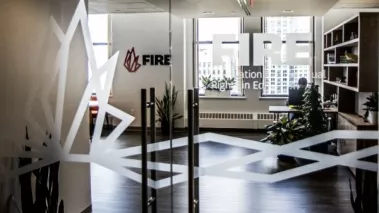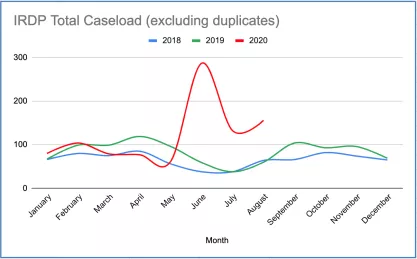Table of Contents
This has been FIRE’s busiest summer ever. What happened?

Summer is usually the quietest time of the year at FIRE. With most classes not in session, there are fewer opportunities for rights violations and not as much need for our commentary and educational resources.
But not this summer.
In June, our Individual Rights Defense Program reviewed 287 cases of alleged rights violations. Over the previous two years, we reviewed an average of 49 cases each June.
In July, IRDP reviewed 132 cases. Over the previous two years, we reviewed an average of 38 cases each July.
In August, IRDP reviewed 156 cases. Over the previous two years, we reviewed an average of 62 cases each August.

While not every case we review fits within FIRE’s mission — that’s true of any month — the number of cases we review functions as a good (albeit imperfect) baseline for determining our workload.
But putting aside the imperfect case submission metric, consider that during the week of August 10, our Individual Rights Defense Program sent its 100th letter to an institution concerning a rights violation this year. Our previous annual record was 83 letters.
We also saw 253,593 unique website pageviews in August — our highest number in 17 months. July accounted for our second-most unique pageviews in that same timeframe (240,606), with June being the third most (212,722). We usually see significant dips in website traffic during the summer, not significant increases. And there were no individual viral articles or content to account for this rise.
So, why the dramatic change this summer from past summers? Why were students and faculty members facing threats to their rights when most institutions were in a summer lull — and why are the calls for help still coming in at a higher rate?
The George Floyd protests and increased anti-racism activism, increased online learning, and, most recently, COVID-19 regulations for on-campus instruction all provide answers to that question.
First, a significant portion of incidents are borne from the heightened political and social tension accelerated by the homicide of George Floyd: where there is conflict and controversy, censorship follows. June and July saw a watershed of viral social media posts revealing racist or antagonistic social media posts by students, incoming freshmen, and faculty, with calls for their institutions to take action. And many institutions did just that, rescinding offers of acceptance or expelling students.
Academics debating questions of racism also faced administrative scrutiny, including at the University of North Texas, where an investigation continues into an academic journal’s discussion of whether a 19th-century music theorist was racist. We have also seen university administrators make dubious pronouncements about what questions can be asked and threaten the “harshest” consequences for speech they view as “hateful” or unsupportive of institutional “values,” First Amendment be damned.
Because censorship is often driven by conflict and controversy, not ideology, these summer months also saw a spike in threats to critics of police, anti-racist advocates, and student journalists. We’ve seen faculty members targeted for incendiary comments about police or because of an elected official’s fear that a “black Antifa flag” on a Facebook profile meant that “Antifa already has a stronghold in our community”; student-athletes facing limits on their social media use as they criticized a coach’s race-based misconduct; and student journalists assaulted by police while covering protests.
Second, the COVID-19 pandemic has led to an increase in questions about due process and expressive rights. As students and faculty return to some campuses, they’re encountering administrators directing RAs not to speak to the media, warning medical school faculty not to speak to the media, and disciplining faculty for social media posts critical of their institutions’ responses to COVID-19. Still others are imposing overbroad contact tracing requirements that present risks to student organizations’ privacy rights.
The George Floyd protests and increased anti-racism activism, increased online learning, and, most recently, COVID-19 regulations for on-campus instruction all provide answers to that question.
Third, these conflicts are exacerbated because more interactions and expression are recorded or conducted via social media. As classes move online, there is a greater likelihood that student and faculty exchanges by email and in class will be recorded — including classroom discussions of difficult material or offhand comments. When these exchanges are shared online (often shorn of mitigating context) or with ideological organizations, they may go viral and lead to calls for action by students, social media critics with no relationship to the institution, or by legislators.
Fourth, FIRE’s caseload has continually risen in the past decade. There are a variety of possible explanations for this. It could be the result of an increase in civic literacy: the more that students and faculty know what their rights are, the more likely they are to recognize threats to them and seek out help. It could also be the result of name recognition, in that students and faculty are more likely to seek FIRE’s help in particular because they know we exist. And, of course, it is possible that the increase in cases also reflects an increase in the rate at which institutions — eager to avoid controversy, turmoil, or exposure to liability — will burden expressive rights.
In times of social and political upheaval, FIRE’s work in protecting freedom of expression — for all — is more important than ever. It will be interesting to see if these trends continue as the fall semester moves forward, particularly as social and political turmoil continues to mount as the fall elections approach.
FIRE defends the rights of students and faculty members — no matter their views — at public and private universities and colleges in the United States. If your rights are in jeopardy, get in touch with us: thefire.org/alarm.
Recent Articles
Get the latest free speech news and analysis from FIRE.

Remembering 'free-thinking' writer Nat Hentoff
Podcast

VICTORY: Court vindicates professor investigated for parodying university’s ‘land acknowledgment’ on syllabus

Can the government ban controversial public holiday displays?
